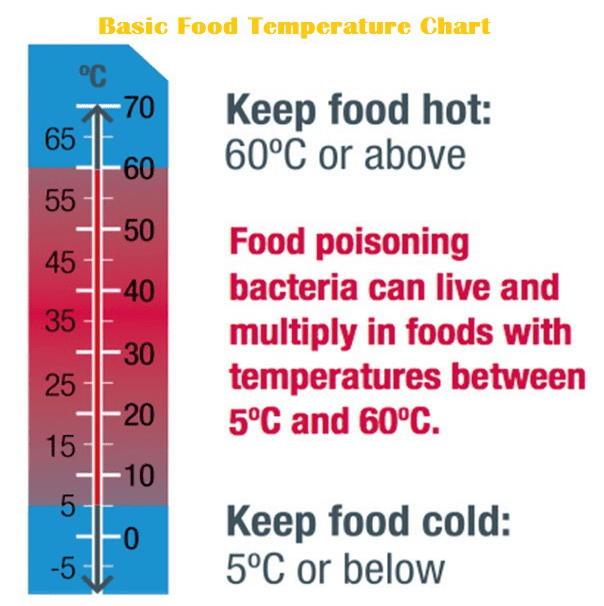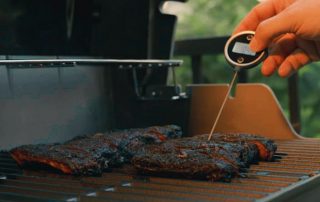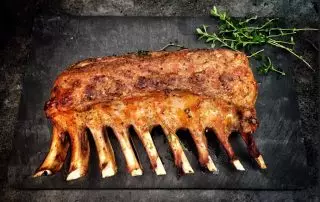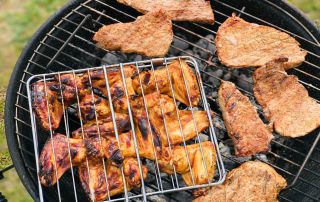Ideal cooking temperature
Baked Goods Temperature Chart
Crunchy bread or juicy cakes – delicacies for the weekend or just to enjoy baking, make sure to have your thermometer at hand!
Check our temperature charts for preparing your favorite cookies

Baked Goods Internal Temperature Chart
If you thought that checking the temperature of your food only applied to meat, you are wrong! Cooking your baked goods to safe internal temperatures is equally as important. Many baked goods contain eggs, which can play host to harmful bacteria.
Even if your baked goods do not contain eggs, it’s important to check the temperature to ensure that your pastry gets fully cooked. From scones to cinnamon rolls, our baked goods internal temperature chart will help you bake your goods to perfection every time.
Fahrenheit and Celsius Cooking Temperatures
Internal Temperature Description
| Internal Core Temperature in Fahrenheit |
Internal Core Temperature in Celsius |
Internal Description | |
|---|---|---|---|
| Breads | Insert the thermometer from the side of the bread. If the bread is in a loaf pan, insert it just above the edge of the pan directing it at a downward angle. | ||
| Quick Breads (Breads, Muffins and Cornbread) | 200°F | 93°C | |
| Yeast Breads | 200°F to 210°F | 93°C to 99°C | |
| Soft Breads/Dinner Rolls | 180°F to 190°F | 82°C to 88°C | |
| Scones | 200°F | 93°C | |
| Sourdough Breads | 200°F to 210°F | 93°C to 99°C | |
| Cinnamon Rolls | 190°F to 200°F | 87°C to 93°C | |
| Water temperature to add yeast | 105°F to 115°F | 41°C to 46°C | |
| Cakes – Cupcakes | 205°F to 209°F | 93°C to 98°C | Insert thermometer in the center of the cake. |
| Carrot Cake | 205°F to 209°F | 93°C to 98°C | Remember: The cooking process continues even after you remove the cake out of the oven. As the cake cools, the residual heat on the surface slowly penetrates to the middle. |
| Clafouti (with fruit) | 160°F | 71°C | |
| Devil’s Food Cake – Red Velvet Cake | 205°F | 93°C | |
| Molton Chocolate Cakes | 160°F | 71°C | |
| Pound Cake | 210°F to 212°F | 99°C to 100°C | |
| Tres Leches Cake, Three-Milk Cake | 200°F | 93°C | |
| Upside-Down Cakes | 190°F to 200°F | 88°C to 93°C | |
| Cheesecake | When the internal temperature of a cheesecake rises beyond 160 degrees F. (71 degrees C.) while baking, it will always crack. To prevent this from happening, Take it out of the oven when the cheesecake reaches 150 degrees F. (65 degrees C.) at the center to avoid over baking. | ||
| Pies | Insert thermometer a couple inches in from the edge of the pie. | ||
| Chocolate Cream Pie | 165°F | 74°C | |
| Custard Pie – Cream Pies | 170°F to 175°F | 76°C to 79°C | Bake until the custard has set around edges but jiggles slightly in the center when tapped on the side with a wooden spoon. |
| Fruit Pies (Blueberry, Blackberry, etc.) | 175°F | 79°C | Fruit pies should be juicy and bubbling all over, especially in its center. The pie needs to bubble if it contains a starch thickener, otherwise the starch is not going to thicken. |
| Pecan Pie | 200°F | 93°C | |
| Pumpkin Pie | 175°F | 79°C | |
| Sweet Potato Pie | 175°F | 79°C | |
| Meringue Pies | 160°F to 165°F | 71°C to 74°C | |
| Puddings and Custards: | Insert thermometer in the centers. Begin checking temperature about 5 minutes before recommended time. | ||
| Bread Pudding | 160°F | 71°C | |
| Creme Brulee | 170°F to 175°F | 76°C to 79°C | |
| Baked Custard (Old Fashion) | 160°F | 71°C | |
| Flan | 170°F to 175°F | 76°C to 79°C |











